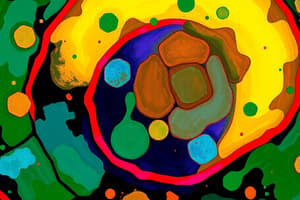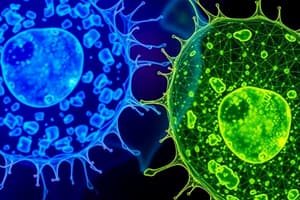Podcast
Questions and Answers
Which structure is primarily responsible for maintaining turgor pressure in plant cells?
Which structure is primarily responsible for maintaining turgor pressure in plant cells?
- Chloroplasts
- Central vacuole (correct)
- Cell wall
- Mitochondria
Which cell structure is involved in both lipid synthesis and detoxification?
Which cell structure is involved in both lipid synthesis and detoxification?
- Smooth endoplasmic reticulum (correct)
- Lysosomes
- Golgi apparatus
- Rough endoplasmic reticulum
In animal cells, what structure facilitates the transmission of electrical signals between adjacent cells?
In animal cells, what structure facilitates the transmission of electrical signals between adjacent cells?
- Gap junctions (correct)
- Extracellular matrix
- Centrosomes
- Cell membrane
Which organelle present in both plant and animal cells is responsible for generating ATP?
Which organelle present in both plant and animal cells is responsible for generating ATP?
What is the primary function of the nucleolus within the nucleus?
What is the primary function of the nucleolus within the nucleus?
Which structure in plant cells converts light energy into chemical energy?
Which structure in plant cells converts light energy into chemical energy?
Which organelle is responsible for the breakdown of cellular waste products?
Which organelle is responsible for the breakdown of cellular waste products?
What general function is shared by the extracellular matrix?
What general function is shared by the extracellular matrix?
Flashcards
Cell Wall
Cell Wall
A rigid outer layer that provides structural support and protection for the plant cell.
Endoplasmic Reticulum (ER)
Endoplasmic Reticulum (ER)
A network of interconnected membranes that's involved in protein synthesis (rough ER) and lipid synthesis (smooth ER).
Nucleus
Nucleus
The cell's control center that houses its genetic material, DNA.
Central Vacuole
Central Vacuole
Signup and view all the flashcards
Mitochondria
Mitochondria
Signup and view all the flashcards
Lysosomes
Lysosomes
Signup and view all the flashcards
Cytoskeleton
Cytoskeleton
Signup and view all the flashcards
Gap Junctions
Gap Junctions
Signup and view all the flashcards
Study Notes
Animal and Plant Cell Similarities and Differences
- Outside the cell:
- Extracellular matrix: Composed of collagen fibers and other components, supporting cells, enabling cell-cell interaction, and receiving external signals.
- Cell membrane: Present in both animal and plant cells, forming a barrier and regulating passage of substances.
- Gap junctions: Channels allowing ion and small molecule passage between animal cells, vital for rapid communication, especially in heart cells.
Inside the cell:
- Cytoplasm: Contains the cell's internal structures.
- Cytoskeleton: Composed of microfilaments, providing structural support and facilitating movement.
- Endoplasmic reticulum: A network of interconnected membranes in both animal and plant cells.
- Rough endoplasmic reticulum: Contains ribosomes, involved in protein synthesis.
- Smooth endoplasmic reticulum: Lacks ribosomes, involved in lipid synthesis and other processes.
- Golgi apparatus: Processes and packages proteins for use within the cell or export.
- Mitochondria: Found in both, producing energy in the form of ATP.
- Nucleus: Encloses genetic material (DNA), connected via nuclear envelope to endoplasmic reticulum.
- Nucleolus: Dense structure within the nucleus, synthesizing ribosomal RNA and forming ribosomes.
- Ribosomes: Essential for protein synthesis, free-floating or attached to rough endoplasmic reticulum.
Plant cell specific features:
- Cell wall: Rigid outer layer providing structural support and protection.
- Central vacuole: Large storage compartment for water, nutrients, waste products.
- May contain harmful substances, maintaining turgor pressure, and assisting in organic compound breakdown.
- Chloroplasts: Sites of photosynthesis, containing chlorophyll used for light energy conversion.
Animal cell-specific features:
- Centrosomes (cell centers): Organizing microtubules, crucial in mitosis (cell division).
- Lysosomes: Containing enzymes breaking down waste, food, and damaged parts; maintaining an acidic environment.
Both Cell Types:
- Peroxisomes: Containing enzymes oxidizing fatty acids, producing hydrogen peroxide; their function is still being researched
- Membranes: Composed of phospholipid bilayers, with hydrophilic heads facing outward and hydrophobic tails inward; comprising cell membrane and internal membranes.
Important Note:
- Many aspects of cell structure and function are under further investigation, with ongoing research on organelles and their interactions.
Studying That Suits You
Use AI to generate personalized quizzes and flashcards to suit your learning preferences.
Description
Explore the similarities and differences between animal and plant cells in this informative quiz. Delve into cellular structures like the extracellular matrix, cell membrane, cytoplasm, and organelles. Test your knowledge on how these cells interact with their environments and each other.





